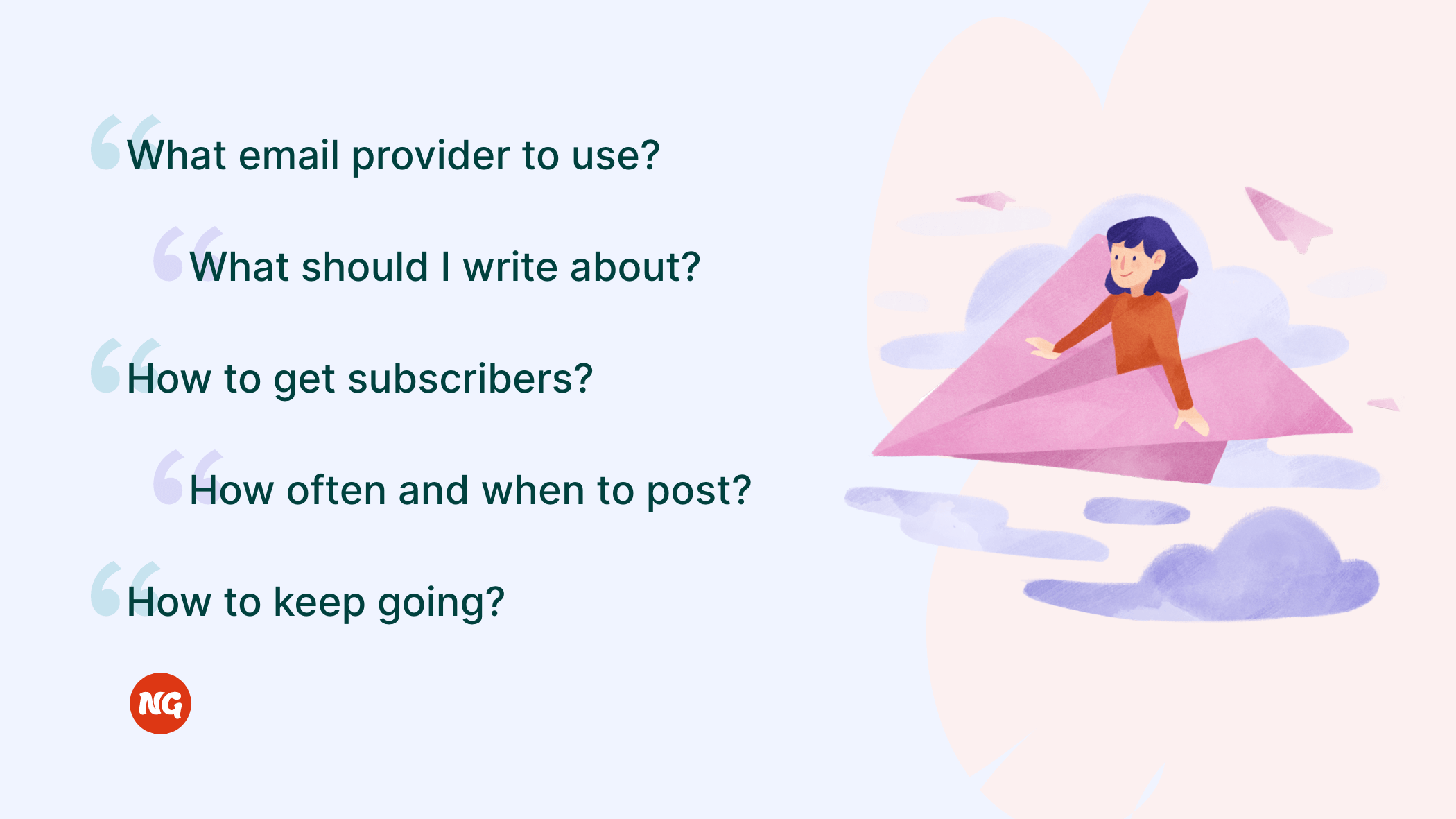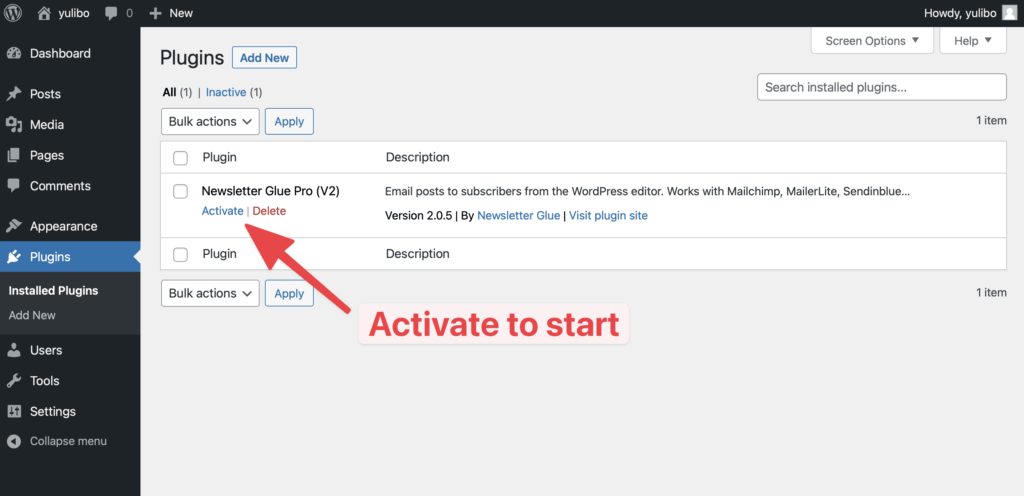One of the best pieces of advice I ever received when starting my own newsletter was from Khe Hy. Here’s what he said:
Aim to write 20 newsletters – @khemaridh Click To TweetThat’s it. But this seemingly simple piece of advice actually takes some work. So let’s go step by step and see what you’ll need to write your first 20 newsletters.
“What email provider should I use?”
Once you’ve decided to start a newsletter, this is typically the first hurdle you need to cross.
You’re likely to spend a lot of time worrying and researching this because you’re excited and eager to choose the perfect tool.
Don’t do this.
Don’t worry about the pros and cons of Mailchimp or ConvertKit or Substack or Revue, just start.
Aim to spend less than an hour choosing and setting up your email provider. And yes, this includes the time you spend reading comparison posts and asking for recommendations on Facebook/Twitter.
If you need a recommendation here you go: Use Substack.
It’s very easy to get started with and you can always switch later.
Resist the temptation to agonise over this. It can be fun, but it’s ultimately not what’s important… I’ll explain why at the end of this post.
“What should I write about?”
Now this is a much better question.
I’m sure you already have a topic for your first issue. After all, the reason you decided to start a newsletter was probably because you were inspired (or angered) by something you read in someone else’s newsletter.
But if you want to figure out what your future newsletters will be about, you might find these simple guidelines helpful:
1. Write about something you’re interested in.
Resist the urge to follow trends.
Instead, write about something you find yourself talking, reading or watching about in your free time.
Why?
Because if you don’t enjoy the topic, you won’t enjoy writing about it. And don’t forget you’ll be writing and researching this topic over and over and over and over again. Every week for years, hopefully!
Something I’ve seen work well for many people is to write a newsletter on a topic they’re learning about. For example, Cedric of Commoncog first started writing about career moats because he was interested in building a career moat for himself.
Do not compromise when it comes to picking a topic you enjoy.
2. Newsletters should follow a theme.
Whether that’s cats, pottery or productivity, pick one and stick to it. People subscribe to newsletters because of their interest in a particular topic.
So if you’re writing about Dungeons & Dragons one week and Chocolate Chip Cookie recipes the next, it’s going to be hard to get people to follow along.
3. Niche down.
Once you’ve picked a theme, pick a subset of that theme. And if that subset still seems too big, apply a location filter and write just for your city.
In other words, niche down.
For example, instead of writing a food blog, write specifically about Biryani in Singapore. Instead of writing about sports, write about the stories of immigrant NBA players.
Why? Because you’ll never be able to cover food as a general topic better than Serious Eats. But it’s possible for you to be the top reviewer of instant noodles in your city’s 7-Elevens.
And once you’ve conquered that niche, it’s easy to expand because you’ll already have an avid following.
“How do I get subscribers?”
So you’ve set up your Substack, written your first post, and have just realised… “I don’t have anyone to send it too!”
Don’t worry. Be your own first subscriber.
Subscriber #1
Send your inaugural newsletter to yourself.
This might sound ridiculous at first, but let me tell you that I still get a thrill receiving my own newsletter in my inbox after all these years.
The ability to read your own work from the eyes of a subscriber is one of the most powerful tools you’ll ever have as a writer. Never downplay its importance.
Reading it on my phone feels completely fresh as compared to when I was proofreading it in the editor.
And without fail, every single time I read my own newsletter, I always find a hundred tiny things I wish I could’ve done better.
Go back, make those improvements, then send a second, edited newsletter to yourself. Then stop there. It doesn’t need to be perfect, it just needs to be better. And making those little improvements can feel quite satisfying.
Also, this second improved newsletter will come in handy later…
Subscribers #2-10
Go through your address book and make a list of all the people you know who would be willing to subscribe to your email list either because they’re your family/friends and are happy to support you, or because you think they’ll be genuinely interested in the topic you’ve chosen to write about.
Then craft a message, share your second newsletter with them as an example of what they should expect to receive, and invite them to subscribe.
Now do you see why it was important to go through the trouble of sending your first newsletter to yourself before getting subscribers?
By giving people a tangible example of what they should expect, you greatly improve the chances of them understanding what you’re talking about and signing up.
Also, you go from “a person that’s just saying they want to start a newsletter” to someone who’s already started. Trust me when I say people will know the difference.
Remember how I mentioned niching down is helpful for getting more subscribers?
Well, let’s imagine the experience of shortlisting 5 biryani-obsessed friends to join your biryani newsletter and contrast that with trying to ask everyone in your entire address book to join your food newsletter.
You can almost guarantee that your 5 biryani-obsessed friends will sign up right away. They’ll probably even volunteer to accompany you on your next “research trip”!
In contrast, if you spam your entire phone book with a message about your new food newsletter, it’s likely you’ll just end up annoying people.
Subscribers #11-50
Now it’s time to let your social media followers know.
After your first round of messages, you probably got some feedback. If necessary, you might even want to edit your newsletter again.
Then write a Facebook/Instagram/Twitter post, be sure to link to your best and latest newsletter as an example, and share it.
To infinity and beyond!
Consistently writing your newsletter then telling people about it is the main way to grow your newsletter. So congratulations, you’ve already begun the most important growth strategy you’ll ever have.
You should be able to grow this way till you reach thousands of subscribers. Remember, good writing written with your subscriber in mind is the best way to grow a newsletter.
Aside from this, here are three other great ways to grow your newsletter:
- Referrals: Include a prominent message at the bottom of your newsletter telling your existing subscribers to share your newsletter with their friends who might like it.
- Cross-promotions/Guest writing: Reach out to fellow newsletter writers whose audiences might be similar to yours and ask if they’d be interested in cross-promoting your newsletter. A simple cross-promotion is where you share a link to their newsletter, and they share a link to yours.
- Helping others: Find people who might be interested in your newsletter and help them. Here’s a tangible way you can do this: Let’s say you’re writing a newsletter on real estate in Perth. Go on Twitter and follow a hundred (or even a thousand) people who’ve tweeted about real estate in Perth. When they ask questions or tweet about the topic, they’ll appear on your Twitter feed. From there, just join in the conversation and help where you can. You don’t even have to promote your newsletter. Instead, simply place a link to sign up for your newsletter in your Twitter bio. Over time, your helpfulness will compound and people will want to subscribe to your newsletter.
Of course, as your newsletter grows, you’ll learn and dream up many other ways to grow. But overcomplicating things at the beginning is a surefire way to feel overwhelmed, convince yourself it’s too difficult and stop.
Much better to keep things simple at the beginning!
“How often and when should I post?”
Just like choosing an email service, this is not important.
Don’t spend any time researching or worrying about it.
Just go with this recommendation: Write weekly and publish on Tuesdays.
You can always change this later on.
“The excitement’s worn off. How do I keep going?”
Whew! By this point, you’ve chosen a publishing tool, written a handful of newsletters and sent them to your first few subscribers.
You. Are. Doing. Awesome.
But here’s where it gets tough.
You’ll soon find that life gets in the way and it’s hard to publish consistently.
This is the point at which you have a decision to make: Do you give up or keep publishing?
Give up
If you find you hate writing after 5 issues, hate being beholden to a deadline, or simple have no time, then give up!
There’s no shame in that. No one will think worse of you. And you can always continue later on since you now have everything set up.
Moreover, you’ll be glad you only spent an hour (rather than 2 weeks) setting everything up and are less likely to suffer from sunk cost fallacy.
Keep going
If you’re enjoying it and your newsletter is growing and improving, keep going! Give yourself a goal of 100 subscribers or 20 issues. The goal itself doesn’t matter that much, but it helps you focus and is good motivation.
“I’ve written my first 20 issues, what’s next?”
If you hit 20 issues like Khe suggests, then you’re well on your way to building a thriving newsletter.
By this time, you probably have a good idea of what you want to do with your newsletter going forward.
For example, some writers love their original set up and have stuck with it for years. They aren’t interested in their newsletter tech stack (and probably don’t even know what that means).
These writers have thousands of subscribers who don’t care a single bit about the tech or the design of the newsletter. They’re here for the quality of the writing.
If that sounds like you, then keep writing, my friend!
Alternatively, if you have bigger ambitions for your publishing platform and feel like it’s time to graduate from Substack, you might enjoy checking out our plugin, Newsletter Glue.
At the risk of preaching to the choir, we connect your email service to WordPress so you can publish newsletters the way you publish blog posts.
Check out some of our other posts or our Newsletter Glue homepage to learn more about us. And if you haven’t already, please subscribe to our newsletter if you found this post helpful and want more like it!


